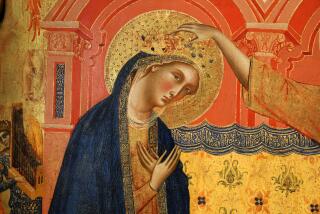Burckhardt Before the Altar : THE ALTARPIECE IN RENAISSANCE ITALY <i> by Jacob Burckhardt, edited, translated and with an introduction by Peter Humfrey (Cambridge University Press: $75 until Feb. 15, 1989; thereafter, $90; 240 pp.; color illustrations throughout; 0-521-36321-7) </i>
- Share via
Jacob Burckhardt’s “Civilization of the Renaissance in Italy,” published in 1860, is one of the greatest and most influential works of art history ever published. Breaking with a tradition of art criticism as old as the Renaissance itself, the great Swiss scholar did not present his history in unbroken chronological sequence but in path-breaking topical essays on such subjects as political life, the recovery of classical learning, the new attitude toward physical reality, and so forth. In each essay, he told his entire story over again, in effect, each time adding something new. The result, like an oil painting to which many thin layers of paint have been applied by a master hand, had a depth and luminosity never before achieved.
Burckhardt intended his great work to be joined by a companion volume on the history of Italian Renaissance art. Though he never finished that work, he did salvage from it near the end of his life, three extended essays, of which this book presents one. Divided into chapters, readably translated, judiciously introduced and annotated by art historian Peter Humfrey, and--above all--gorgeously illustrated with dozens of the works to which Burckhardt refers, it is a book that amateurs may read with pleasure even if, as I suspect, it may be mainly of historical interest to professionals.
The art of the Renaissance was overwhelmingly a religious art; and its central artifact--after the church building itself--was the altarpiece. A short course in the altarpiece becomes inevitably a short course in all that went into an altarpiece: not just painting, sculpture and architecture but also cosmology, theology and politics. Burckhardt’s problem-and-solution approach to art criticism seems particularly rewarding here where the problems--size, materials, placement, function and ideology--were so large.
Although he was born in Switzerland, Jacob Burckhardt is the very paradigm of a German scholar; and German scholarship is, in some quarters, synonymous with pedantry. Burckhardt, however, is one German scholar who, even in a late and secondary work, may always be read for pleasure, at least when the works to which he refers are as beautifully displayed for the reader as they are in this unexpected and welcome edition.
More to Read
The biggest entertainment stories
Get our big stories about Hollywood, film, television, music, arts, culture and more right in your inbox as soon as they publish.
You may occasionally receive promotional content from the Los Angeles Times.









